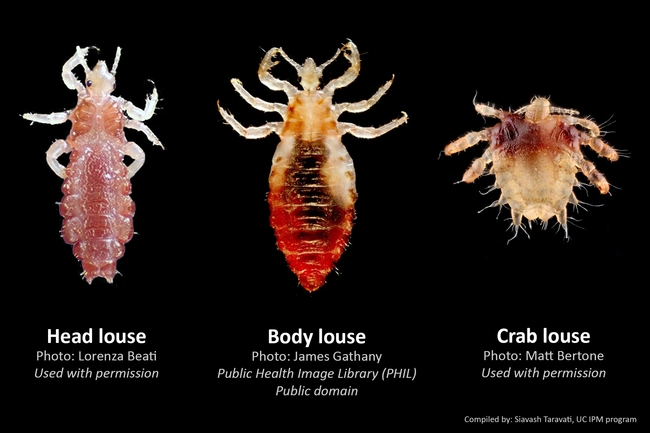Human lice (singular “louse”) are parasitic insects found on people. Adult lice are small (about 1/8 inch (3 mm) long or less) wingless insects that move by crawling. There are three species of lice that exclusively feed on humans: the head louse, the body louse, and the crab or pubic louse.
The head louse (Pediculus humanus capitis) and the body louse (Pediculus humanus humanus) are members of the same species, but the crab (pubic) louse (Pthirus pubis) is from a different insect family. All are pests of public health importance. Treatment is usually prescribed by medical professionals and should be focused on the infested person and their belongings. Use the following descriptions to identify these pests and help your clients seek out proper care from medical professionals.
Crab louse
These lice have a short, round body (not elongated), with hairy tubercles (small, knobby projections of the body wall) on the abdomen. The front legs are shorter and slimmer than the middle and hind legs (Figure 1). Adults and eggs are usually found on pubic hairs but may sometimes be found on other areas of the body such as beards, mustaches, eyelashes, and underneath the arms.
Head louse vs. body louse
Unlike the crab louse, these lice have elongated bodies (Figure 1) and lack tubercles on their abdomen. Head and body lice look almost identical since they are members of the same species. Positive identification requires consideration of specific morphological and behavioral differences (see Table 1). Body lice are known to transmit serious human diseases such as epidemic typhus, trench fever, and louse-borne relapsing fever. Head lice are not known to be an effective vector of diseases even when a pathogen is found in the louse's body.
Human lice elimination involves removal of lice from human body as well as from clothing and living environments. A head lice infestation on a person should be managed by the client. Head lice can be removed with a lice comb or treated with special lice shampoo or lotions containing one or more active ingredients. Human lice have developed resistance to many over-the-counter products containing permethrin or other pyrethroids. Therefore, it is believed that the most effective head lice treatment products are the ones containing ivermectin or spinosad. Body lice can be killed by dry cleaning clothing and bed sheets. Also, vacuuming and treating carpets may improve body lice management especially when the infestation is heavy. Body lice infestations can also be managed by reducing crowding and improving body and clothing hygiene. Head lice infestations, however, are not associated with poor hygiene, at least in developed countries.
For more details about the head louse, including thorough management options and guidance, see the recently revised Pest Notes: Head Lice.
[Article originally published in the Fall 2020 issue of the Green Bulletin.]

